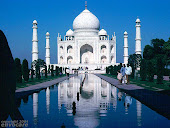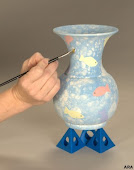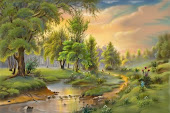main |
sidebar



A miniature by Roberts from this time shows Margaret as a delicate woman with blonde ringlets, holding the smiling three-year-old Christine. But Roberts' family life was not as idyllic as this picture suggests: Margaret had become an alcoholic, and eventually, in 1831, Roberts sent her back to Scotland to be cared for by friends. Roberts may have burned some letters from this period in shame at his wife's drinking problem, but he was unusually frank in a letter to a friend, David Ramsay Hay. Roberts and Hay had been apprentices together, and Hay had been seeing a mistress since his own wife had started drinking.
If you do not know our cases are approximately parallel. Yours is not as bad as mine, having some consolation. The state of my nerves is such I can scarcely write.
While he built his reputation as a fine artist, Roberts's stage work had also been commercially successful. Commissions from Covent Garden included the sets for the London premiere of Mozart’s Die Entführung aus dem Serail in 1827, scenery for a pantomime depicting the naval victory of Navarino, and two panoramas that he executed jointly with Stanfield.
By 1829 he was working full-time as a fine artist. That year, he exhibited the Departure of the Israelites from Egypt, in which his style first became apparent. In 1831, the Society of British Artists elected him as their president, the next year he traveled in Spain and Tangiers. He returned at the end of 1833 with a supply of sketches that he elaborated into attractive and popular paintings. The British Institution exhibited his Interior of Seville Cathedral in 1834, and he sold it for £300. He executed a fine series of Spanish illustrations for the Landscape Annual of 1836. Then in 1837 a selection of his Picturesque Sketches in Spain was reproduced by lithography.

Nuclear powered icebreakers are faraway more powerful than their diesel powered counterparts, and have been constructed by Russia primarily to aid shipping in the frozen Arctic waterways in the north of Siberia.
During the winter, the ice along the northern seaways varies in thickness from (1.2 to 2.0 meters). The ice in central parts of the Arctic Ocean is on average 2.5 meters (8.2 ft) thick. Nuclear-powered icebreakers can power through this ice at speeds up to 10 knots (19 km/h, 12 mph).

There was also shaped gold and ivory fastened about them all; and many resemblances of the war, and those in several ways, and variety of contrivances, affording a most lively portraiture of it. For there was to be seen a joyful country laid waste, and entire squadrons of enemies slain; while some of them ran away, and some were carried into captivity; with walls of great altitude and magnitude overthrown and ruined by machines; with the strongest defenses taken, and the walls of most populous cities upon the tops of hills seized on, and an army pouring itself within the walls; as also every place full of slaughter, and supplications of the enemies, when they were no longer able to lift up their hands in way of opposition..
Fire also sent upon temples was here represented, and houses overthrown, and falling upon their owners: rivers also, after they came out of a large and melancholy desert, ran down, not into a land cultivated, nor as drink for men, or for cattle, but through a land still on fire upon every side; for the Jews related that such a thing they had undergone during this war.











Wednesday, March 30, 2011

Since the Renaissance the Pantheon has been used as a tomb. Among those buried there are the painters Raphael and Annibale Carracci, the composer Arcangelo Corelli, and the architect Baldassare Peruzzi. In the 15th century, the Pantheon was adorned with paintings: The best-known is the Annunciation by Melozzo da Forlì. Architects, like Brunelleschi, who used the Pantheon as help when designing the Cathedral of Florence's dome, looked to the Pantheon as inspiration for their works.
Pope Urban VIII (1623 to 1644) ordered the bronze ceiling of the Pantheon's portico melted down. Most of the bronze was used to make bombards for the fortification of Castel Sant'Angelo, with the remaining amount used by the Apostolic Camera for various other works. It is also said that the bronze was used by Bernini in creating his famous baldachin above the high altar of St.
Peter's Basilica, but, according to at least one expert, the Pope's accounts state that about 90% of the bronze was used for the cannon, and that the bronze for the baldachin came from Venice. This led the Roman satirical figure Pasquino to issue the famous proverb: Quod non fecerunt barbari fecerunt Barberini.
In 1747, the broad frieze below the dome with its false windows was “restored,” but bore little resemblance to the original. In the early decades of the twentieth century, a piece of the original, as could be reconstructed from Renaissance drawings and paintings, was recreated in one of the panels.
Pope Urban VIII (1623 to 1644) ordered the bronze ceiling of the Pantheon's portico melted down. Most of the bronze was used to make bombards for the fortification of Castel Sant'Angelo, with the remaining amount used by the Apostolic Camera for various other works. It is also said that the bronze was used by Bernini in creating his famous baldachin above the high altar of St.
Peter's Basilica, but, according to at least one expert, the Pope's accounts state that about 90% of the bronze was used for the cannon, and that the bronze for the baldachin came from Venice. This led the Roman satirical figure Pasquino to issue the famous proverb: Quod non fecerunt barbari fecerunt Barberini.
In 1747, the broad frieze below the dome with its false windows was “restored,” but bore little resemblance to the original. In the early decades of the twentieth century, a piece of the original, as could be reconstructed from Renaissance drawings and paintings, was recreated in one of the panels.
Wednesday, March 23, 2011

Born to a Jewish family of Murdoch (Max) Halsman, a dentist, and Ita Grintuch, a grammar school principal, in Riga, Halsman studied electrical engineering in Dresden.
In September 1928, Halsman went on a mountaineering tour in the Austrian Alps with his father, Murdoch. During this tour, Murdoch died from severe head injuries. The circumstances were never completely clarified and Halsman was sentenced to four years' custody for patricide. The case provoked anti-Jewish propaganda and thus gained international publicity, and Albert Einstein and Thomas Mann wrote in support of Halsman. Halsman was released in 1931, under the condition that he leaves Austria for good, never to return.
Halsman consequently left Austria for France. He began contributing to fashion magazines such as fashion and soon gained a reputation as one of the best portrait photographers in France, renowned for his sharp and closely cropped images that shunned the old soft focus look. When France was invaded, Halsman fled to Marseille and he eventually managed to obtain a U.S. visa, aided by family friend Albert Einstein.
Halsman had his first success in America when the cosmetics firm Elizabeth Arden used his image of model Constance Ford against the American flag in an advertising campaign for "Victory Red" lipstick. A year later in 1942 he found work with Life, photographing hat designs, one of which, a portrait of a model in a Lilly Daché hat, was his first of the many covers he would do for Life.
In 1941 Halsman met the surrealist artist Salvador Dali and they began to collaborate in the late 1940s. The 1948 work Dali Atomicus explores the idea of suspension, depicting three cats flying, a bucket of thrown water, and Salvador Dali in mid air. The title of the photograph is a reference to Dali’s work Leda Atomica which can be seen in the right of the photograph behind the two cats. Halsman reported that it took 28 attempts to be fulfilled with the result. Halsman and Dali eventually released a compendium of their collaborations in the 1954 book Dali's Mustache, which features 36 different views of the artist's distinctive mustache.
Another famous collaboration between the two was In Voluptas Mors, a surrealistic portrait of Dali beside a large skull, in fact a tableau vivant composed of seven nudes. Halsman took three hours to arrange the models according to a sketch by Dali. A version of In Voluptas Mors was used subtly in the poster for the film The Silence of The Lambs, and recreated in a poster for the film The Descent.
Monday, March 14, 2011

In 1822 the Co burg Theatre, now the Old Vic in London, offered Roberts a job as a pretty designer and stage painter. He sailed from Leigh with his wife and the six-month-old Christine and settled in London. After working for a while at the Co burg Theatre, Roberts moved to the Theatre Royal, Drury Lane to create dioramas and panoramas with Stanfield.
A miniature by Roberts from this time shows Margaret as a delicate woman with blonde ringlets, holding the smiling three-year-old Christine. But Roberts' family life was not as idyllic as this picture suggests: Margaret had become an alcoholic, and eventually, in 1831, Roberts sent her back to Scotland to be cared for by friends. Roberts may have burned some letters from this period in shame at his wife's drinking problem, but he was unusually frank in a letter to a friend, David Ramsay Hay. Roberts and Hay had been apprentices together, and Hay had been seeing a mistress since his own wife had started drinking.
If you do not know our cases are approximately parallel. Yours is not as bad as mine, having some consolation. The state of my nerves is such I can scarcely write.
While he built his reputation as a fine artist, Roberts's stage work had also been commercially successful. Commissions from Covent Garden included the sets for the London premiere of Mozart’s Die Entführung aus dem Serail in 1827, scenery for a pantomime depicting the naval victory of Navarino, and two panoramas that he executed jointly with Stanfield.
By 1829 he was working full-time as a fine artist. That year, he exhibited the Departure of the Israelites from Egypt, in which his style first became apparent. In 1831, the Society of British Artists elected him as their president, the next year he traveled in Spain and Tangiers. He returned at the end of 1833 with a supply of sketches that he elaborated into attractive and popular paintings. The British Institution exhibited his Interior of Seville Cathedral in 1834, and he sold it for £300. He executed a fine series of Spanish illustrations for the Landscape Annual of 1836. Then in 1837 a selection of his Picturesque Sketches in Spain was reproduced by lithography.
Friday, March 11, 2011

A nuclear powered icebreaker is a purpose-built ship for use in waters constantly covered with ice. Icebreakers are ships capable of cruising on ice-covered water by breaking through the ice with their strong, heavy, steel bows.
Nuclear powered icebreakers are faraway more powerful than their diesel powered counterparts, and have been constructed by Russia primarily to aid shipping in the frozen Arctic waterways in the north of Siberia.
During the winter, the ice along the northern seaways varies in thickness from (1.2 to 2.0 meters). The ice in central parts of the Arctic Ocean is on average 2.5 meters (8.2 ft) thick. Nuclear-powered icebreakers can power through this ice at speeds up to 10 knots (19 km/h, 12 mph).
In ice-free waters the maximum speed of the nuclear-powered icebreakers is as much as 21 knots (35 km/h, 24 mph).
Monday, March 7, 2011

From the 3rd century BC, a specific genre known as Triumphal Paintings appeared, as indicated by Pliny (XXXV, 22). These were paintings which showed triumphal entries after military victories, represented episodes from the war, and occupied regions and cities. Summary maps were drawn to highlight key points of the movement. Josephus describes the painting executed on the occasion of Vespasian and Titus's sack of Jerusalem:
There was also shaped gold and ivory fastened about them all; and many resemblances of the war, and those in several ways, and variety of contrivances, affording a most lively portraiture of it. For there was to be seen a joyful country laid waste, and entire squadrons of enemies slain; while some of them ran away, and some were carried into captivity; with walls of great altitude and magnitude overthrown and ruined by machines; with the strongest defenses taken, and the walls of most populous cities upon the tops of hills seized on, and an army pouring itself within the walls; as also every place full of slaughter, and supplications of the enemies, when they were no longer able to lift up their hands in way of opposition..
Fire also sent upon temples was here represented, and houses overthrown, and falling upon their owners: rivers also, after they came out of a large and melancholy desert, ran down, not into a land cultivated, nor as drink for men, or for cattle, but through a land still on fire upon every side; for the Jews related that such a thing they had undergone during this war.
Now the workmanship of these representations was so magnificent and lively in the construction of the things, which it exhibited what had been done to such ads did not see it, as if they had been there really present. On the top of every one of these pageants was placed the commander of the city that was taken, and the manner wherein he was taken.
Friday, March 4, 2011

The Colosseum, or the Coliseum, initially the Flavian Amphitheatre, is an egg-shaped amphitheatre in the centre of the city of Rome, Italy, the largest ever built in the Roman Empire. It is considered one of the greatest works of Roman architecture and Roman engineering.
Occupying a site just east of the Roman Forum, its construction started in 72 AD under the emperor Vespasian and was completed in 80 AD under Titus, with further modifications being made during Domitian's reign (81–96). The name "Amphitheatrum Flavium" derives from both Vespasian's and Titus's family name.
Capable of seating 50,000 spectators, the Colosseum was used for gladiatorial contests and public spectacles such as mock sea battles, animal hunts, executions, re-enactments of famous battles, and dramas based on Classical mythology. The building ceased to be used for entertainment in the early medieval era. It was later reused for such purposes as housing, workshops, and quarters for a religious order, a fortress, a extract, and a Christian shrine.
Although in the 21st century it stays moderately ruined because of damage caused by devastating earthquakes and stone-robbers, the Colosseum is an iconic symbol of Imperial Rome. It is one of Rome's most popular tourist attractions and still has close connections with the Roman Catholic Church, as each Good Friday the Pope leads a torchlight "Way of the Cross" procession that starts in the area around the Colosseum.
Occupying a site just east of the Roman Forum, its construction started in 72 AD under the emperor Vespasian and was completed in 80 AD under Titus, with further modifications being made during Domitian's reign (81–96). The name "Amphitheatrum Flavium" derives from both Vespasian's and Titus's family name.
Capable of seating 50,000 spectators, the Colosseum was used for gladiatorial contests and public spectacles such as mock sea battles, animal hunts, executions, re-enactments of famous battles, and dramas based on Classical mythology. The building ceased to be used for entertainment in the early medieval era. It was later reused for such purposes as housing, workshops, and quarters for a religious order, a fortress, a extract, and a Christian shrine.
Although in the 21st century it stays moderately ruined because of damage caused by devastating earthquakes and stone-robbers, the Colosseum is an iconic symbol of Imperial Rome. It is one of Rome's most popular tourist attractions and still has close connections with the Roman Catholic Church, as each Good Friday the Pope leads a torchlight "Way of the Cross" procession that starts in the area around the Colosseum.
;;
Subscribe to:
Posts (Atom)
Tajmahal Paintings

Painting Iteams

Creation of Paintings

Painting Equipments

Beautiful Rose Painting

Green Nature Painting

Canvas Painting

Pictute of Artist

Color Paintings

Online Paintings
